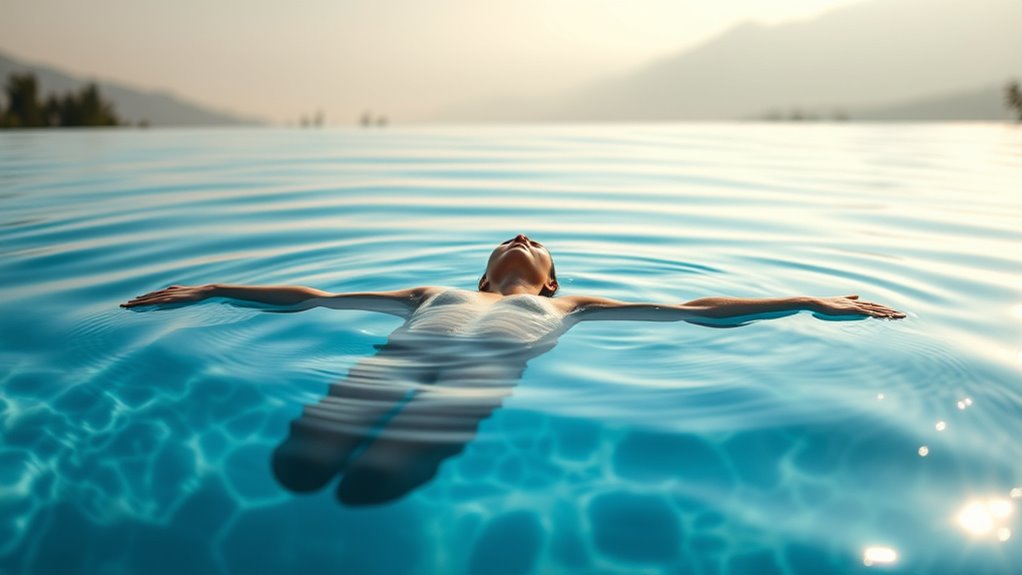Floating feels therapeutic because it creates a sensory-free environment that calms your nervous system, reducing stress hormones like cortisol. The buoyancy supports your muscles, easing tension and promoting deep relaxation. This environment also shifts your brain activity toward peaceful alpha and theta states associated with relaxation and meditation. As you experience this calming effect, your body and mind reset, helping you manage stress better. Keep exploring to uncover more about how floating truly transforms your well-being.
Key Takeaways
- Sensory deprivation reduces external stimuli, allowing the nervous system to shift into a relaxed, calm state.
- Buoyancy alleviates muscle tension and joint pressure, promoting physical relaxation and lowering stress hormones.
- Slowed brain wave activity during floating enhances alpha and theta states, associated with relaxation and meditative calmness.
- Focused awareness of bodily sensations during floating fosters mindfulness, reducing mental reactivity and emotional stress.
- Regular floating supports long-term stress resilience by improving sleep, emotional stability, and overall mental health.

Have you ever experienced the soothing sensation of floating in water? It’s a uniquely calming experience that can instantly ease tension and ground you in the present moment. When you float, your body enters a state of sensory deprivation, meaning your senses are minimized, and your mind can settle into a peaceful stillness. This environment naturally promotes mindfulness techniques, allowing you to focus solely on your breath, heartbeat, or the gentle sensation of water supporting your body. The weightlessness reduces physical stress, but it also has profound effects on your mental state. As your body relaxes, your nervous system shifts from a state of alertness to one of deep relaxation, helping reduce cortisol levels and lowering anxiety.
The science behind why floating feels so therapeutic lies in how it influences your physiology. When you’re immersed in a float tank, the absence of external stimuli diminishes distractions, making it easier to quiet your mind. This sensory deprivation can slow down brain waves, promoting alpha and theta states associated with relaxation and meditation. As your brain enters these calmer states, you’re less reactive to everyday stressors, which helps reset your mental outlook. Plus, the buoyancy of the water supports your body in a way that relieves muscle tension and joint pressure, encouraging a profound physical relaxation that complements the mental calm. Additionally, research into contrast ratio in projectors demonstrates how controlling visual elements can influence relaxation and focus, linking the importance of sensory management to overall well-being.
Floating also encourages a natural form of mindfulness, where you become more aware of your bodily sensations and breathing patterns. With fewer distractions, you can practice mindfulness techniques more effectively, observing your thoughts without judgment and simply being present. This heightened awareness fosters a sense of clarity and emotional balance. The sensation of floating, combined with sensory deprivation, fundamentally creates a meditative environment that’s accessible even to those new to mindfulness practices. It’s like giving your mind a gentle reset, free from the overwhelm of sensory overload.
Floating fosters natural mindfulness by heightening awareness of bodily sensations and breath, creating a calming, meditative environment for all.
Most importantly, the physiological effects of floating aren’t just temporary. Regular sessions can improve your overall stress response, enhance sleep quality, and boost mental resilience. You learn to better manage stress outside the tank by incorporating mindfulness techniques into daily life. The calming effects penetrate deep into your nervous system, helping you develop a more relaxed and centered outlook. So, next time you float, remember that this simple act isn’t just about feeling weightless — it’s about nurturing your mind and body through profound relaxation rooted in the principles of sensory deprivation and mindfulness.
Frequently Asked Questions
How Long Should a Typical Floating Session Last for Maximum Benefits?
For maximum benefits, a typical floating session should last about 60 to 90 minutes, as this duration allows your body and mind to fully relax and enter deeper states of calm. Ideal timing varies per person, but staying within this range helps you experience the full physiological and mental benefits of floating. If you’re new, start with 60 minutes and gradually extend your session as you become more comfortable.
Can Floating Help Alleviate Chronic Physical Pain or Injuries?
Floating can definitely help with pain relief and injury recovery. The buoyant environment reduces pressure on your joints and muscles, easing chronic pain. It also promotes relaxation and improves circulation, which supports healing. Many people find float therapy accelerates recovery from injuries by calming inflammation and releasing tension. If you’re seeking a natural way to manage persistent pain or recover faster, floating could be a beneficial addition to your healing routine.
Are There Any Risks or Contraindications Associated With Floating Therapy?
Floating therapy is generally safe, but you should consider dive safety and skin sensitivity. If you have open wounds, skin conditions, or infections, it’s best to consult your doctor first. Be cautious if you’re prone to skin allergies or sensitivities, as the saltwater may cause irritation. Always follow proper procedures, and inform staff of any health concerns to make certain of a safe and relaxing experience.
How Does Floating Compare to Other Relaxation Techniques Like Meditation?
Floating offers a unique mindfulness comparison to meditation by immersing you in sensory deprivation, which helps clear your mind more effectively. Unlike traditional meditation, floating minimizes external stimuli, allowing you to reach a deeper state of relaxation quickly. You actively engage in this process, experiencing increased mental calmness and physical ease. Both techniques promote relaxation, but floating’s sensory deprivation amplifies the calming effects, making it a powerful alternative or complement to meditation.
Is Prior Experience or Skill Needed to Fully Benefit From Floating Sessions?
You don’t need prior experience or skills to fully benefit from floating sessions. Imagine diving into a world where sensory deprivation unbolts deep relaxation, much like mindfulness meditation but with an even greater sense of calm. Whether you’re a beginner or a seasoned meditator, floating helps your mind and body reset effortlessly. Just show up, relax, and let the experience guide you to tranquility, no expertise required.
Conclusion
Floating can truly transform your relaxation experience, helping you unwind and reduce stress. Did you know that just 30 minutes of floating can lower cortisol levels by up to 30%? That’s a significant boost for your overall well-being. So, next time you seek calm, give floating a try. It’s a simple, effective way to tap into your body’s natural relaxation response and feel refreshed—mind, body, and soul.










